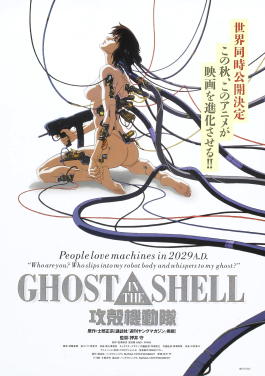3.5 out of 5 stars
After reading Scalzi‘s Filmcritic.com post this week, which featured nine science fiction movies I might have overlooked, I added several of them to my Netflix queue(s) (both disk and streaming) with the intention of watching at least one of them over the weekend. A few on his list I watched years ago. Since I didn’t get my last disk in the mail until last Friday, I decided to watch the cyberpunk anime almost cult classic Ghost in the Shell. I have Destination Moon (co-written by Heinlein, who also served as a technical adviser on the film) in the mail for Monday night.
I couldn’t have avoided anime if I tried with two artists for offspring. My son, Derek, especially fits the target audience for this subject matter, although I’m not sure the deeper philosophical ‘meaning of life’ questions would have been absorbed by his consciousness a decade ago (when he was a sophomore in high school). I remember my daughter being caught up in the Pokemon fad, even taking her to the movie theater to watch a film based on that character. My personal favorite remains Miyazaki’s post-apocalyptic fantasy adventure film Nausicaa of the Valley of the Winds. I not only own an unabridged subtitled (not dubbed) DVD but the manga as well. But I’m partial to post-apocalyptic tales.
Cyberpunk, on the other hand, just doesn’t do much for me. Several years ago, I read the classic Gibson novel Neuromancer as part of a group read for discussion. I still haven’t gotten around to reading the other cyberpunk ‘must read’ Snow Crash by Stephenson. So I started Ghost in the Shell with some trepidation.
I enjoyed the visuals. Kudos to mid-90s tech and the seamless integration of traditional animation (well, traditional for the Japanese anyway) and computer graphics. I focused on the deeper undercurrents, the ghostly whispers heard by the protagonist, Major Kusanagi, and her musings and conclusions derived therefrom.
I found it odd, and perhaps a bit ironic, that the climax erupts in an abandoned museum, riddling murals of dinosaur fossils and a tree of ‘life’ rooted in ectoplasmic ancient history and branching up to the pinnacle of hominids with bullet holes, culminating with the evolution of a new life form from the ruins and desolation of human endeavors.
But what really got me scratching my head came during the epilogue, with an awakened and evolved cybernetic child’s first image, seen dimly across the room, is her own image in a dark mirror. And just a few seconds lately, she explains to her ex-partner and rescuer, the meaning behind her previous whispers, and then quotes the Bible! Specifically 1 Corinthians 13, with just touch of artistic license to add some personalization for the character.
When I was a child, I spoke like a child, I thought like a child, I reasoned like a child; when I became an adult, I put an end to childish ways.
1 Cor 13:11 (NRSV)
But it’s the next verse that whispered to her earlier:
For now we see in a mirror, dimly, but then we will see face to face. Now I know only in part; then I will know fully, even as I have been fully known.
1 Cor 13:12 (NRSV)
This verse is no stranger to science fiction. Philip K. Dick used it obliquely in the title of his 1977 novel A Scanner Darkly. I think there’s even an original Star Trek episode that includes some variation on this verse, perhaps it was Mirror, Mirror?
Other translations of the twelfth verse offer different reflections:
For now we see through a glass, darkly ; but then face to face: now I know in part; but then shall I know even as also I am known.
KJV
Now we see things imperfectly as in a poor mirror, but then we will see everything with perfect clarity. All that I know now is partial and incomplete, but then I will know everything completely, just as God knows me now.
NLT
It is the same with us. Now we see a dim reflection, as if we were looking into a mirror, but then we shall see clearly. Now I know only a part, but then I will know fully, as God has known me.
NCV
I must assume the use of these quoted verses by the director and/or writers of Ghost in the Shell plucked them from First Corinthians and intended to use them completely out of context with the rest of the thirteenth chapter (more commonly known as ‘The Love Chapter’ and a frequent wedding vow inspiration). For there was little of love, an absence of faith, and a scarcity of hope, for humans at least, in the Ghost in the Shell.
So these three things continue forever: faith, hope, and love. And the greatest of these is love.
1 Cor 13:13 (NCV)
 Destination Moon (1950)
Destination Moon (1950)








